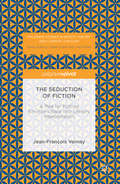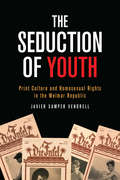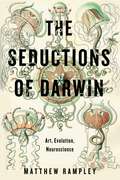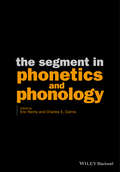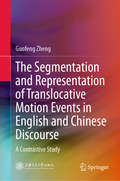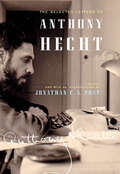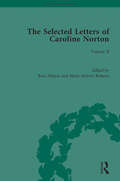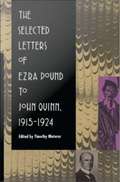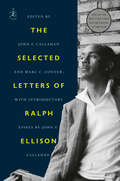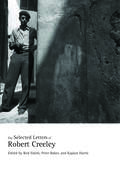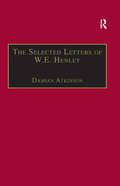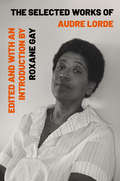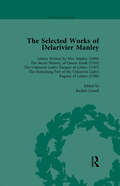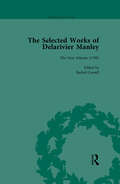- Table View
- List View
The Seduction of Fiction
by Jean-François VernayBy meshing psychology with literary analysis, this book inspires us to view the reading of fictional works as an emotional and seductive affair between reader and writer. Arguing that current teaching practices have contributed to the current decline in the study of literature, Jean-Fran#65533;ois Vernay's plea brings a refreshing perspective by seeking new directions and conceptual tools to highlight the value of literature. Interdisciplinary in focus and relevant to timely discussions of the vitality between emotion and literary studies, particularly within the contexts of psychology, affect studies, and cognitive studies, this book will open up a space in which the formation of our emotions can be openly examined and discussed.
The Seduction of Youth: Print Culture and Homosexual Rights in the Weimar Republic (German and European Studies)
by Javier Samper VendrellA simple man from the provinces, Friedrich Radszuweit merged popular culture, consumerism, and politics as the leader of the League for Human Rights, Germany’s first mass homosexual organization. The Seduction of Youth is the first study to focus on the League and its leader, using his position at the centre of the Weimar-era gay rights movement to tease out the diverging political strategies and contradictory tactics that distinguished the movement. By examining news articles and opinion pieces, as well as literary texts and photographs in the League’s numerous pulp magazines for homosexuals, Javier Samper Vendrell reconstructs forgotten aspects of the history of same-sex desire and subjectivity. While recognizing the possibilities of liberal rights for sexual freedom during the Weimar Republic, the League’s "respectability politics" failed in part because Radszuweit’s own publications contributed to the idea that homosexual men were considered a threat to youth, doing little to change the views of the many people who believed in homosexual seduction – a homophobic trope that endured well into the twentieth century.
The Seductions of Darwin: Art, Evolution, Neuroscience
by Matthew RampleyThe surge of evolutionary and neurological analyses of art and its effects raises questions of how art, culture, and the biological sciences influence one another, and what we gain in applying scientific methods to the interpretation of artwork. In this insightful book, Matthew Rampley addresses these questions by exploring key areas where Darwinism, neuroscience, and art history intersect.Taking a scientific approach to understanding art has led to novel and provocative ideas about its origins, the basis of aesthetic experience, and the nature of research into art and the humanities. Rampley’s inquiry examines models of artistic development, the theories and development of aesthetic response, and ideas about brain processes underlying creative work. He considers the validity of the arguments put forward by advocates of evolutionary and neuroscientific analysis, as well as its value as a way of understanding art and culture. With the goal of bridging the divide between science and culture, Rampley advocates for wider recognition of the human motivations that drive inquiry of all types, and he argues that our engagement with art can never be encapsulated in a single notion of scientific knowledge.Engaging and compelling, The Seductions of Darwin is a rewarding look at the identity and development of art history and its complicated ties to the world of scientific thought.
The Seductions of Darwin: Art, Evolution, Neuroscience
by Matthew RampleyThe surge of evolutionary and neurological analyses of art and its effects raises questions of how art, culture, and the biological sciences influence one another, and what we gain in applying scientific methods to the interpretation of artwork. In this insightful book, Matthew Rampley addresses these questions by exploring key areas where Darwinism, neuroscience, and art history intersect.Taking a scientific approach to understanding art has led to novel and provocative ideas about its origins, the basis of aesthetic experience, and the nature of research into art and the humanities. Rampley’s inquiry examines models of artistic development, the theories and development of aesthetic response, and ideas about brain processes underlying creative work. He considers the validity of the arguments put forward by advocates of evolutionary and neuroscientific analysis, as well as its value as a way of understanding art and culture. With the goal of bridging the divide between science and culture, Rampley advocates for wider recognition of the human motivations that drive inquiry of all types, and he argues that our engagement with art can never be encapsulated in a single notion of scientific knowledge.Engaging and compelling, The Seductions of Darwin is a rewarding look at the identity and development of art history and its complicated ties to the world of scientific thought.
The Seeley Lectures: The Sleeping Sovereign
by Richard TuckRichard Tuck traces the history of the distinction between sovereignty and government and its relevance to the development of democratic thought. Tuck shows that this was a central issue in the political debates of the seventeenth and eighteenth centuries, and provides a new interpretation of the political thought of Bodin, Hobbes and Rousseau. Integrating legal theory and the history of political thought, he also provides one of the first modern histories of the constitutional referendum, and shows the importance of the United States in the history of the referendum. The book derives from the John Robert Seeley Lectures delivered by Richard Tuck at the University of Cambridge in 2012, and will appeal to students and scholars of the history of ideas, political theory and political philosophy.
The Segment in Phonetics and Phonology
by Eric Raimy Charles E. CairnsThe Segment in Phonetics and Phonology unravels exactly what the segment is and on what levels it exists, approaching the study of the segment with theoretical, empirical, and methodological heterogeneity as its guiding principle. A deliberately eclectic approach to the study of the segment that investigates exactly what the segment is and on what level it exists Includes new research data from a diverse range of fields such as experimental psycholinguistics, language acquisition, and mathematical theories of communication Represents the major theoretical models of phonology, including Articulatory Phonology, Optimality Theory, Laboratory Phonology and Generative Phonology Examines both well-studied languages like English, Chinese, and Japanese and under-studied languages such as Southern Sierra Miwok, Päri, and American Sign Language
The Segmentation and Representation of Translocative Motion Events in English and Chinese Discourse: A Contrastive Study
by Guofeng ZhengThis book provides a systematic, contrastive analysis of the segmentation and representation of English and Chinese Translocative Motion Events (TMEs), which possess Macro-Event Property (MEP). It addresses all the issues critical to understanding TMEs in English and Chinese, from event segmentation, MEP principles and the conceptual structure of TMEs and their constituents, to the representation of Actant, Motion, Path and Ground. The book argues that the corpus-based alignment for the TME segmentation in both languages, the parameters of Actant, Motion, Path and Ground and their relevant statistical description are particularly important for understanding English and Chinese TMEs. The linguistic materialization of Actant, Ground, Path and Motion, together with a wealth of tables and figures, offers convincing evidence to support the typological classification of English and Chinese. The book’s suggestions regarding the Talmyan bipartite typology and Bohnemeyer’s MEP contribute to the advancement of TME studies and language typology, and help learners to understand motion events and English-Chinese typological similarities and differences.
The Seizure of Power
by Czeslaw Milosz Celina WieniewskaNovel by the Nobel Prize winner for Literature about the month in 1944 when Nazi rule over Europe was crumbling and the Red Army pushed into Poland to meet the Western Allies on the Elbe.
The Selected Letters of Anthony Hecht
by Anthony HechtSpanning seven decades, these often intimate, brilliantly astute letters by the eminent poet Anthony Hecht reflect a body of work that influenced the history of twentieth-century American poetry.Pulitzer Prize-winning poet Anthony Hecht (1923–2004) was known not only for his masterful control of form and language but also for his wit and humor. With the help of Helen Hecht, the poet’s widow, Jonathan F. S. Post combed through more than 4,000 letters to produce an intimate look into the poet’s mind and art across a lifetime. The letters range from Hecht’s early days at summer camp to college at Bard, to the front lines of World War II, to travels abroad in France and Italy, to marriage, and to fame as a poet and critic. Along the way, Hecht corresponded with well-known poets such as John Hollander, James Merrill, Anne Sexton, and Richard Wilbur. Those interested in the lives of contemporary poets will read these highly personal letters with delight and surprise.
The Selected Letters of Caroline Norton: Volume I (The Pickering Masters)
by Ross Nelson; Marie Mulvey-RobertsThis is the first volume of a three volume collection of the correspondence of Caroline Norton, covering the period July 1828-Deember 1837. The collection also includes an introduction and five commentaries by the editor, contextualising and embedding Caroline’s literary and political achievements within the narrative of her letters.
The Selected Letters of Caroline Norton: Volume II (The Pickering Masters)
by Ross Nelson; Marie Mulvey-RobertsThis is the second volume of a three volume collection of the correspondence of Caroline Norton, covering the period January 1838-November 1857. The collection also includes an introduction and five commentaries by the editor, contextualising and embedding Caroline’s literary and political achievements within the narrative of her letters.
The Selected Letters of Caroline Norton: Volume III (The Pickering Masters)
by Ross Nelson; Marie Mulvey-RobertsThis is the third volume of a three volume collection of the correspondence of Caroline Norton, covering the period February 1858-June 1877. The collection also includes an introduction and five commentaries by the editor, contextualising and embedding Caroline’s literary and political achievements within the narrative of her letters.
The Selected Letters of Ezra Pound to John Quinn 1915-1924
by Timothy MatererThis volume provides a first-hand survey of the arts and literature during a crucial period in modern culture, 1915-1924. Pound was then associated with such germinal magazines as BLAST, The Little Review, The Egoist, and Poetry; he was discovering or publicizing writers such as Robert Frost, Hilda Doolittle, T. S. Eliot, and James Joyce; and he was championing the painters Wyndham Lewis and William Wadsworth as well as the sculptors Jacob Epstein, Henri Gaudier-Brzeska, and Constantin Brancusi. Pound wrote to John Quinn--a New York lawyer, an expert in business law, and a collector of unusual taste and discrimination--about these artists and many more, urging him to support their journals, collect their manuscripts, and buy and exhibit their paintings and sculptures. Quinn at one time owned manuscripts of Ulysses and The Waste Land, Brancusi's sculpture Mlle. Pogany, and Picasso's painting Three Musicians. Yet he was often skeptical about the value of new schools of art, such as Vorticism, and disturbed by the outspokenness of authors such as Joyce. Pound's letters are unusually tactful when he counters Quinn's doubts and explains the premises of experimental art. Pound's letters to Quinn are touched with his characteristic humor and wordplay and are especially notable for their lucidity of expression, engendered by Pound's deep respect for Quinn.
The Selected Letters of Ralph Ellison: The Selected Letters Of Ralph Ellison And Albert Murray (Modern Library Ser.)
by Ralph EllisonA radiant collection of letters from the renowned author of Invisible Man that trace the life and mind of a giant of American literature, with insights into the riddle of identity, the writer&’s craft, and the story of a changing nation over six decades These extensive and revealing letters span the life of Ralph Ellison and provide a remarkable window into the great writer&’s life and work, his friendships, rivalries, anxieties, and all the questions about identity, art, and the American soul that bedeviled and inspired him until his death. They include early notes to his mother, written as an impoverished college student; lively exchanges with the most distinguished American writers and thinkers of his time, from Romare Bearden to Saul Bellow; and letters to friends and family from his hometown of Oklahoma City, whose influence would always be paramount. These letters are beautifully rendered first-person accounts of Ellison&’s life and work and his observations of a changing world, showing his metamorphosis from a wide-eyed student into a towering public intellectual who confronted and articulated America&’s complexities.
The Selected Letters of Robert Creeley
by Robert Creeley Peter Baker Kaplan Harris Rod SmithRobert Creeley is one of the most celebrated and influential American poets. A stylist of the highest order, Creeley imbued his correspondence with the literary artistry he brought to his poetry. Through his engagements with mentors such as William Carlos Williams and Ezra Pound, peers such as Charles Olson, Robert Duncan, Denise Levertov, Allen Ginsberg, and Jack Kerouac, and mentees such as Charles Bernstein, Anselm Berrigan, Ed Dorn, Susan Howe, and Tom Raworth, Creeley helped forge a new poetry that re-imagined writing for his and subsequent generations. This first-ever volume of his letters, written between 1945 and 2005, document the life, work, and times of one of our greatest writers, and represent a critical archive of the development of contemporary American poetry, as well as the changing nature of letter-writing and communication in the digital era.
The Selected Letters of W.E. Henley (The Nineteenth Century Series)
by Damian AtkinsonThe text of the book consists of some 150 letters (out of a corpus of 2,500) written by the late nineteenth-century poet, critic, editor and journalist W.E. Henley, to various figures of the period, e.g. R.L. Stevenson, H. G. Wells, J.M. Barrie, William Archer, Rodin, Wilde, Kipling, Arthur Morrison, Alice Meynell, and Edmund Gosse. Letters are also included to other figures within Henley’s immediate circle, his wife Anna, his financial backer Fitzroy Bell, Charles Baxter the arbitrator in the quarrel between Henley and Stevenson, and his Edinburgh art collector friend Hamilton Bruce. Each letter is fully annotated. An introduction places Henley within the period and provides a biographical account of his life and literary work which is reflected in his letters. Of particular importance is the role of Henley as editor of London, the Magazine of Art, the Scots Observer and later the National Observer and the New Review.
The Selected Letters of Willa Cather
by Willa Cather Janis Stout Andrew Jewell<P>This first publication of the letters of one of America's most consistently admired writers is both an exciting and a significant literary event. <P>Willa Cather, wanting to be judged on her work alone, clearly forbade the publication of her letters in her will. <P>But now, more than sixty-five years after her death, with her literary reputation as secure as a reputation can be, the letters have become available for publication. <P>The 566 letters collected here, nearly 20 percent of the total, range from the funny (and mostly misspelled) reports of life in Red Cloud in the 1880s that Cather wrote as a teenager, through those from her college years at the University of Nebraska, her time as a journalist in Pittsburgh and New York, and during her growing eminence as a novelist. <P>Postcards and letters describe her many travels around the United States and abroad, and they record her last years in the 1940s, when the loss of loved ones and the disasters of World War II brought her near to despair. <P>Written to family and close friends and to such luminaries as Sarah Orne Jewett, Robert Frost, Yehudi Menuhin, Sinclair Lewis, and the president of Czechoslovakia, Thomas Masaryk, they reveal her in her daily life as a woman and writer passionately interested in people, literature, and the arts in general. <P>The voice heard in these letters is one we already know from her fiction: confident, elegant, detailed, openhearted, concerned with profound ideas, but also at times funny, sentimental, and sarcastic. <P>Unfiltered as only intimate communication can be, they are also full of small fibs, emotional outbursts, inconsistencies, and the joys and sorrows of the moment. <P>The Selected Letters is a deep pleasure to read and to ponder, sure to appeal to those with a special devotion to Cather as well as to those just making her acquaintance.
The Selected Works of Audre Lorde
by Audre LordeA definitive selection of Audre Lorde’s "intelligent, fierce, powerful, sensual, provocative, indelible" (Roxane Gay) prose and poetry, for a new generation of readers. Self-described "black, lesbian, mother, warrior, poet" Audre Lorde is an unforgettable voice in twentieth-century literature, and one of the first to center the experiences of black, queer women. This essential reader showcases her indelible contributions to intersectional feminism, queer theory, and critical race studies in twelve landmark essays and more than sixty poems—selected and introduced by one of our most powerful contemporary voices on race and gender, Roxane Gay. Among the essays included here are: "The Transformation of Silence into Language and Action" "The Master’s Tools Will Never Dismantle the Master’s House" "I Am Your Sister" Excerpts from the American Book Award–winning A Burst of Light The poems are drawn from Lorde’s nine volumes, including The Black Unicorn and National Book Award finalist From a Land Where Other People Live. Among them are: "Martha" "A Litany for Survival" "Sister Outsider" "Making Love to Concrete"
The Selected Works of Delarivier Manley Vol 1
by Rachel Carnell W R Owens Ruth HermanA modern critical edition of the works of Delarivier Manley, providing complete texts of all her works, reset and with annotations. It includes findings on Manley's work as a political propagandist and scholarship on her part in the history of the novel.
The Selected Works of Delarivier Manley Vol 2
by Rachel Carnell W R Owens Ruth HermanA modern critical edition of the works of Delarivier Manley, providing complete texts of all her works, reset and with annotations. It includes findings on Manley's work as a political propagandist and scholarship on her part in the history of the novel.
The Selected Works of Delarivier Manley Vol 3 (The\pickering Masters Ser.)
by Rachel Carnell W R Owens Ruth HermanA modern critical edition of the works of Delarivier Manley, providing complete texts of all her works, reset and with annotations. It includes findings on Manley's work as a political propagandist and scholarship on her part in the history of the novel.
The Selected Works of Delarivier Manley Vol 4 (The\pickering Masters Ser.)
by Rachel Carnell W R Owens Ruth HermanA modern critical edition of the works of Delarivier Manley, providing complete texts of all her works, reset and with annotations. It includes findings on Manley's work as a political propagandist and scholarship on her part in the history of the novel.
The Selected Works of Delarivier Manley Vol 5
by Rachel Carnell W R Owens Ruth HermanA modern critical edition of the works of Delarivier Manley, providing complete texts of all her works, reset and with annotations. It includes findings on Manley's work as a political propagandist and scholarship on her part in the history of the novel.
The Selected Works of Margaret Oliphant, Part I Volume 1: Literary Criticism 1854-69 (The\pickering Masters Ser.)
by Elisabeth Jay Joanne ShattockMargaret Oliphant (1828-97) had a prolific literary career that spanned almost fifty years. She wrote some 98 novels, fifty or more short stories, twenty-five works of non-fiction, including biographies and historic guides to European cities, and more than three hundred periodical articles. This is the most ambitious critical edition of her work.
The Selected Works of Margaret Oliphant, Part I Volume 2: Literary Criticism 1870-76
by Joanne WilkesMargaret Oliphant (1828-97) had a prolific literary career that spanned almost fifty years. She wrote some 98 novels, fifty or more short stories, twenty-five works of non-fiction, including biographies and historic guides to European cities, and more than three hundred periodical articles. This is the most ambitious critical edition of her work.
